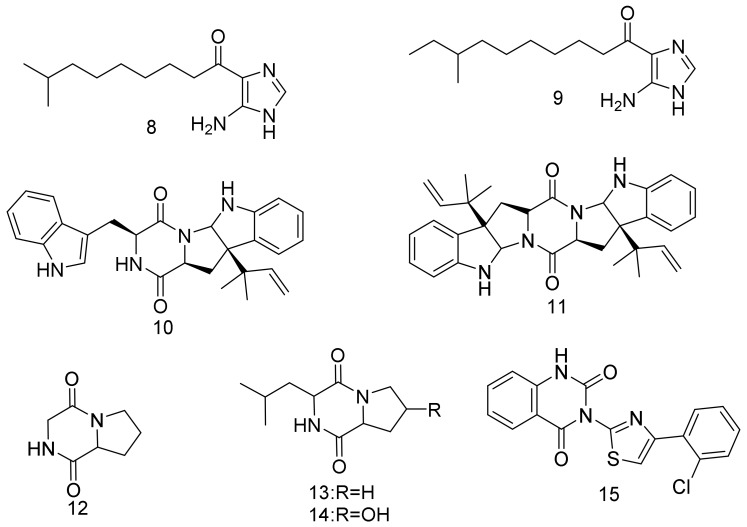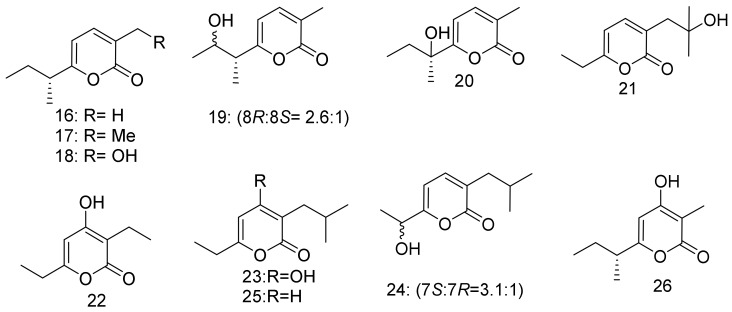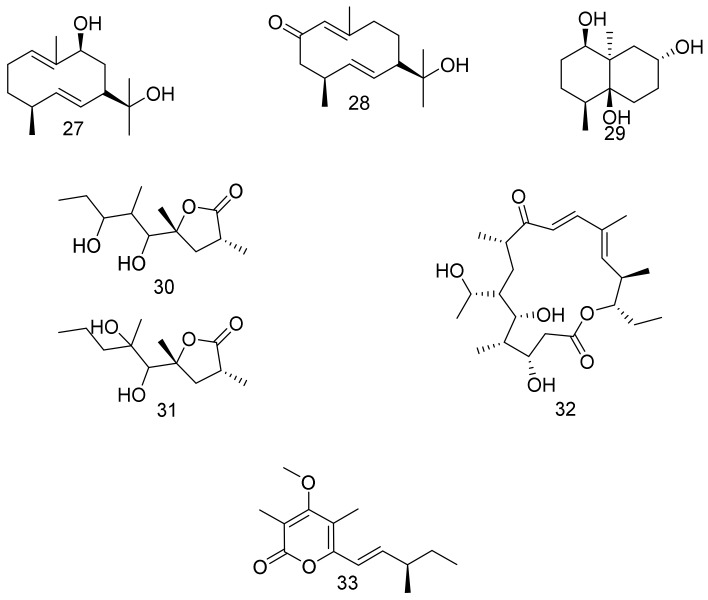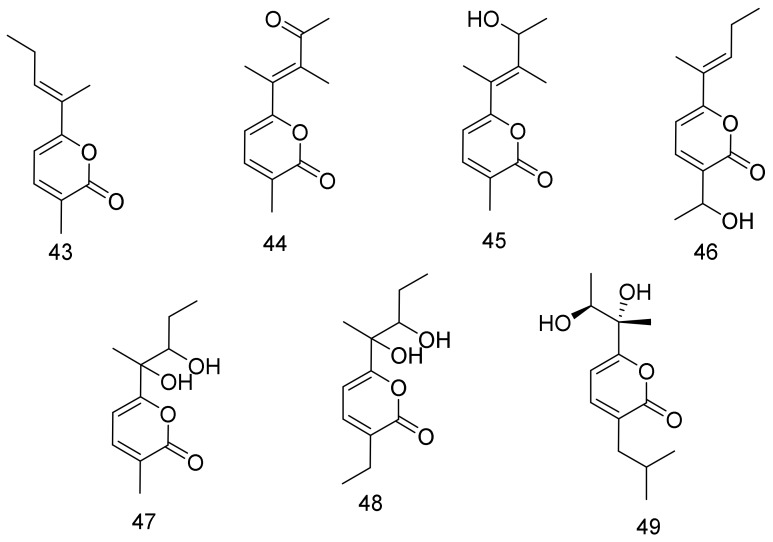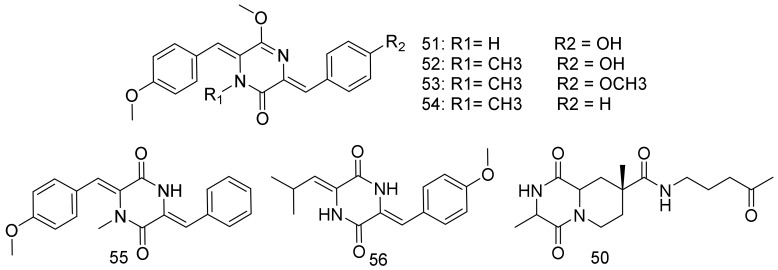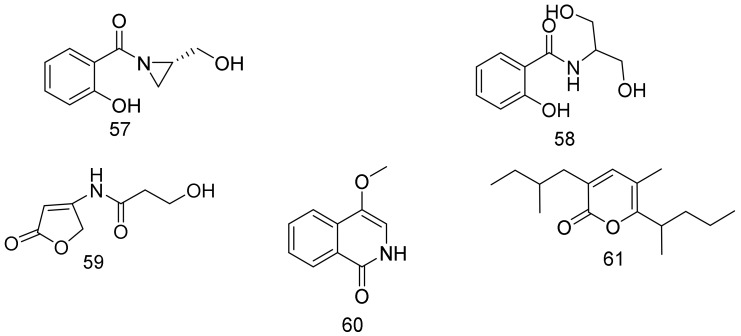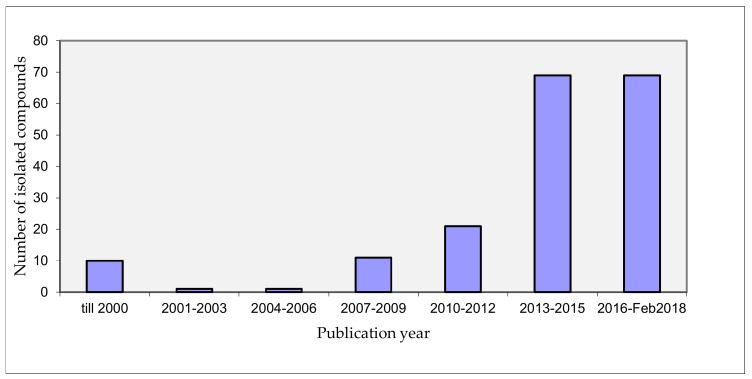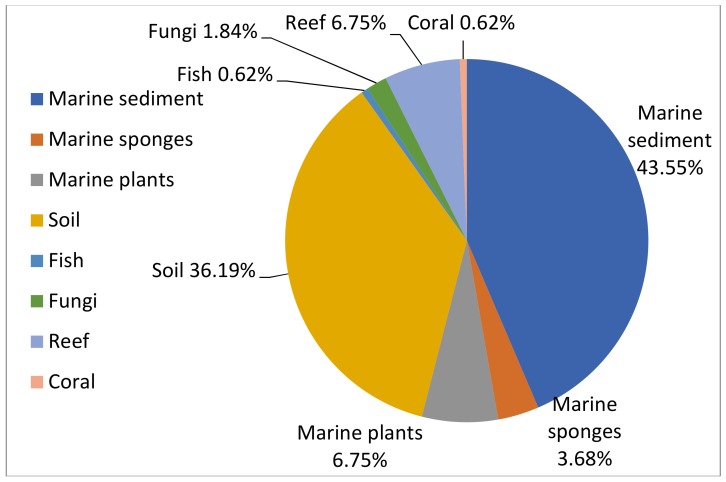Abstract
Actinomycetes are a relevant source of novel bioactive compounds. One of the pharmaceutically and biotechnologically important genera that attract natural products research is the genus Nocardiopsis, mainly for its ability to produce a wide variety of secondary metabolites accounting for its wide range of biological activities. This review covers the literature from January 2015 until February 2018 making a complete survey of all the compounds that were isolated from the genus Nocardiopsis, their biological activities, and natural sources, whenever applicable.
Keywords: bioactive, actinomycetes, Nocardiopsis, natural products, diversity
1. Introduction
Actinobacteria represent one of the largest bacterial phyla, and it is distributed in both terrestrial and marine ecosystems [1,2]. Actinobacteria are prolific producers of a vast variety of bioactive secondary metabolites acting mainly as antiviral, antifungal, anti-trypanosomal, antileishmanial, antimalarial, antibacterial, cytotoxic, antioxidant, and anti-inflammatory drugs [3,4,5,6]. Pharmaceutically active secondary metabolites derived from Actinobacteria account for approximately 70% of the naturally derived compounds that are currently in clinical use [3,4,7]. The first description of the genus Ncardiopsis was in 1976 by J. Mayer [8]. Nocardiopsis belongs to the order Actinomycetales, family Nocardiopsaceae, and morphologically, it is similar to members of the genera Actinomadura and Nocardia [8,9]. Nocardiopsis species are a Gram-positive, aerobic, halotolerant, and catalase positive actinomycetes. It possesses nocardioform mycelia with long chains of spores on the aerial parts. The genus Nocardiopsis is associated with different ecosystems, namely, terrestial as plant epiphytes and endophytes, in addition to marine environments [10].
Bennur et al. made a literature survey on genus Nocardiopsis detailing the bioactive compounds isolated prior to 2015 [11]. Reviewing the literature on the genus Nocardiopsis, it could produce a wide variety of chemical classes of compounds with diverse biological activities. Secondary metabolites are mainly polyketides [12,13], cyclic peptides [14,15], macrolides [16], diketopiperazines [17,18], α-pyrones [19,20] γ-pyrones [19], alkaloids [21], naphthoquinones [22], phenazines [23], and phenoxazine derivatives [24], which are responsible for a wide spectrum of pharmacological and biological effects , mainly as antibacterial [14], antifungal [25], anticancer [23], antitumour [26], cytotoxic [22,27], immunomodulatory [16], and protein kinase inhibitory [28]. It is also pharmaceutically important for the production of biosurfactants [29]. Within this review, we aim to introduce the most recently discovered chemical diversity that is found in Nocariopsis.
Nocarbenzoxazoles A−G (1−7, Figure 1) are new benzoxazole derivatives isolated from Nocardiopsis lucentensis DSM 44048. Nocarbenzoxazole G (7) showed a cytotoxic activity against HepG2 and HeLa with IC50 (half maximal inhibitory concentration, concentration causing 50% of the desired activity) values of 3 and 1 μM, respectively. Nocardiopsis lucentensis DSM 44048 is a halophilic strain that was obtained from a soil sample [30].
Figure 1.
Structural formulas of 1–7.
Chemical investigation of Nocardiopsis sp. (strain CNQ115) obtained from marine sediments collected from southern California coasts led to the isolation of nocarimidazoles A (8) and B (9) as two new 4-aminoimidazole alkaloids. Nocarimidazole A (8) showed weak antibacterial activities against Bacillus subtilis and Staphylococcus epidermidis, with MIC (minimum inhibitory concentration) values of 64 μg/mL [31]. Two diketopiperazines, (10) and (11), were isolated as SOAT2 (acyl-CoA:cholesterolacyltransferase (ACAT), EC 2.4.1.26) inhibitors from Nocardiopsis sp. KM2-16. The study on the cell-based assay showed that (11) selectively inhibited SOAT2 activity with a SI (selective index) value of 62. The strain Nocardiopsis sp. KM2-16 was isolated in 2012 from sea sediments collected off the coasts of Iriomote Island, Okinawa, Japan [32]. Three diketopiperazines (12–14) were isolated from Nocardiopsis umidischolae KMM 7036. Compound 13 had the strongest cytotoxicity on OSS (the fertility of spermatozoids) test and on the development of embryos of sea urchin (Strongylocentrotus intermedius). At the early blastula stage (5 h), compounds 12–14 did not affect fertilization and embryo development at a concentration of 100 µg/mL. Nevertheless, storage of the embryos in the presence of these compounds (up to 20 h) blocked the embryo development. This led to cell death and embryos lysis, mainly for (13). Compounds 12 and 14 showed cytotoxic activity against splenocytes [33]. A quinazoline derivative identified as 3-[40-(2″-chlorophenyl)-20-thiazolyl]-2,4-dioxo-1,2,3,4-tetrahydroquinazoline (15) was isolated from soil-derived Nocardiopsis alba that was collected from Western Ghat hills. The compound inhibited telomerases in a Telomeric Repeat Amplification Protocol (TRAP assay) in a cell-free system. Telomerase inhibitory activity was inferred from the reduction in the intensity of the telomerase-elongated TS primers, as compared to the band intensity of internal assay standard (TSNT). Compound 15 was thus suggested to be a suitable molecule for developing a future anticancer drug due to its selectivity towards G-quadruplex over normal DNA duplex and showing lower cytotoxicity for normal cells [34]. Structures are shown in Figure 2.
Figure 2.
Structural formulas of 8–15.
Eleven α-pyrones 16–26 (Figure 3) were isolated from three Nocardiopsis strains namely, SCSIO 04583, SCSIO 10419, and SCSIO KS107. Compounds 17, 19, 21, 24, and 25 displayed a moderate growth inhibition against Micrococcus luteus, while 16 and 25 showed mild inhibition against Bacillus subtilis. The marine- derived Nocardiopsis strains were cultivated from the reef sediment sample that was obtained from Xieyang Island, Beihai, Guangxi Province, China [35].
Figure 3.
Structural formulas of 16–26.
9β-hydroxyl germacradienol (1(10)E,5E-germacradiene-9β,11-diol) (27) and 2-oxygermacradienol (11-hydroxy-1(10)E,5E-germacradien-2-one) (28) are two germacradiene-type sesquiterpenes isolated from Nocardiopsis chromatogenes YIM 90109 together with (1β,4β,4aβ,7α,8aα)-4,8a-dimethyloctahydronaphthalene-1,4a,7(2H)-triol (29) geosmin-type sesquiterpene. Nocardiopsis chromatogenes YIM 90109 is a halophilic strain obtained from a saline soil sample collected from Xinjiang Province, China. Compounds 27–29 were inactive as antibacterial in paper disc diffusion assay against the tested microbes at 30 μg/disc [36]. Lucentides A (30) and B (31) are polyketides that were isolated from Nocardiopsis lucentensis DSM 44048, together with 19-hydroxyprotylonolide (32) all of which had no antimicrobial activities against the tested strains [37]. Marinopyrone D (33) was identified from Nocardiopsis sp. strain CNQ-675, cultivated from the marine sediment obtained from La Jolla, California, and found to inhibit NO (nitric oxide) production with IC50 value of 13 µM. On the other hand, compound 33 had no significant antibacterial activity against a panel of tested Gram-negative and Gram-positive strains. Furthermore, compound 33 at concentrations up to 100 µM was nontoxic to the human renal carcinoma cell line (A498) and the human pancreatic cell lines (MIA-PaCa and PANC-1) [38]. Structures are shown in Figure 4.
Figure 4.
Structural formulas of 27–33.
Borrelidins C–E (34–36), new 18-membered macrolides along with a previously reported borrelidin (37) were isolated from halophilic Nocardiopsis strain. Belonging to the rare borrelidin class of antibiotics, borrelidins C (34) and D (35) showed antibacterial activity against Salmonella enterica ATCC 14028, which is a Gram-negative pathogen with MIC values of 16 μM and 63 μM, respectively. Borrelidin C (34) displayed cytotoxic activity against SNU638 and K562 cell lines with IC50 values of 5.5 μM and 5.7 μM, respectively. Borrelidin D (35) showed comparable cytotoxicity against SNU638 and K562 with IC50 values of 8.7 μM and 6.7 μM, respectively, whereas borrelidin E (36) did not display cytotoxic activity against any of the tested cancer cell lines. The halotolerant Nocardiopsis strain was obtained from Jeung-do Island in Shinan-gun, Jeollanamdo, Korea from a hypersaline saltern topsoil samples [39]. A halophilic Nocardiopsis strain HR-4 was isolated from a soil sample that was collected from a salt lake in Algerian Sahara. 16S rDNA gene sequence analysis strongly suggests that Nocardiopsis strain HR-4 represents novel species. Bioactivity tests with extracts of strain HR-4 showed an antibacterial activity against namely S. aureus, E. faecalis, and M. luteus, as well as antifungal properties against S. cerevisiae and C. albicans. Chemical investigations led to the isolation and identification of two major angucyclinones, namely, 8-O-methyltetrangomycin (38) and (−)-7-deoxy-8-O-methyltetrangomycin (39) [40]. Structures are shown in Figure 5.
Figure 5.
Structural formulas of 34–39.
A cytotoxic compound isomethoxyneihumicin (40/41, Figure 6) that was isolated as a mixture of lactam-lactim tautomers together with methoxyneihumicin (42) was obtained from Nocardiopsis alba KM6-1. Isomethoxyneihumicin (40/41) and methoxyneihumicin (42) arrested the cell cycle of Jurkat cells in 12 h at the G2/M phase (66 and 67%) at concentrations of 15.0 μM. Both (40/41) and 42 displayed a cytotoxic activity in 20 h against Jurkat cells with IC50 values of 6.98 and 30.5 μM, respectively. These findings suggest that the exhibited cytotoxicity against Jurkat cells is by inhibiting the cell cycle at the G2/M phase. Nocardiopsis alba KM6-1 was isolated from the sea sediment samples from Chichijima, Ogasawara, Japan in 2013 [41].
Figure 6.
Structural formulas of 40–42.
Nocapyrones O-S (44–48), along with nocapyrone F (43), are α-pyrones that were isolated from Nocardiopsis sp. YIMM13066 cultured from deep-sea sediment samples. None of the isolated α-pyrones showed any significant cytotoxic activity at 50 μM against PC3, H1299, HeLa, MCF-7, HL7702, and U251 cell lines [42].
A new α-pyrone (49) was isolated from the deep-sea (Arctic Ocean) actinomycete Nocardiopsis dassonvillei subsp. Dassonvillei DSM 43111(T) together with five known compounds. Compound 49 did not show any cytotoxicity against MCF-7, K562, A375, SGC7901, HepG2, and Hela cell lines. The five known compounds were identified as cyclo-(L-Pro-L-Val), cyclo-(L-Pro-L-Leu), cyclo-(L-Pro-L-Ile), N-(2-hydroxyphenyl)-acetamide, and (4-aminophenyl) acetic acid [43]. Structures are shown in Figure 7.
Figure 7.
Structural formulas of 43–49.
Nocarazepine A (50), which is a diketopiperazine, was purified from Nocardiopsis alba, which was cultured from Anthogorgia caerulea, that was obtained from the coast of Xieyang Island, Guangxi Province [44]. Six diketopiperazines, of which, two new nocazines F (51) and G (52), and four known (53–56) were identified from the deep-sea sediment derived Nocardiopsis sp. YIM M13066. Compounds 51 and 52 showed a broad spectrum and excellent cytotoxicity against human cancer cell lines PC3, H1299, HL7702, HeLa, MCF-7, and U251. The most potent was (52) against H1299 with IC50 2.60 μM and 51 against H1299 and MCF-7 with IC50 3.87 μM and 3.86 μM, respectively. Only (52) showed moderate antibacterial activity against B. subtilis ATCC 6051, with an MIC of 25.8 μM. Compounds 51–56 were assayed for inhibitory activity against T3SS (type three secretion system) of S. enteric serovar Typhimurium UK-1 χ8956. All of the compounds exhibited inhibitory activity at concentration of 100 μM against the secretion of SPI-1 effector SipA/B/C/D and no effects on FliC. Among them, compound 51 exhibited the strongest dose-dependent inhibition on the secretion of the SPI-1 effector SipC (from 5 to 100 μM) [45]. Structures are shown in Figure 8.
Figure 8.
Structural formulas of 50–56.
N-Salicyloyl-2-aminopropan-1,3-diol (58), together with a rare aziridine derivative, madurastatin B3 (57), were isolated from Nocardiopsis sp. LS150010, and both of them exhibited significant antibacterial activity against S. aureus and MRSA (methicillin resistant S. aureus), with MIC values of 6.25 μg/mL. Compound 57 showed potent antibacterial activity against Escherichia coli and Bacillus subtilis in addition to potent anti-tuberculosis activity using a BCG-infected THP-1 cell model assay. It showed a significant inhibition of BCG in THP-1 cells growth down to concentrations of 0.156 μg/mL. Remarkably, the active concentration in the infected model was much lower than the MIC value in the cell-based model, which indicates that it may target the pathogen-host interaction. The strain LS150010 was cultured from the soil sample from Sejila Mountain Virgin Forest (altitude 3900 m), southeastern Tibet, China [46].
3′-hydroxy-N-(2-oxo-2,5-dihydrofuran-4-yl) propionamide (59) and 4-methoxy-2H-isoquinolin-1-one (60) were isolated together with eight known compounds from Nocardiopsis lucentensis sp. ASMR2, which is a new marine strain that was identified from marine plants that were collected from the Red Sea coasts, Hurghada, Egypt. The known compounds were identified as cyclo-(Tyr, Pro), adenosine, indole-3-acetic acid, indole-3-acetic acid methyl ester, indole-3-carboxylic acid, furan-2,5-dimethanol, tyrosol, and glycerol linoleate. Both the filtrate and the cell extracts of Nocardiopsis lucentensis sp. ASMR2 displayed moderate antibacterial activity against Gram-positive bacteria (8–12 mm). Interestingly, the extracts of Nocardiopsis lucentensis sp. ASMR2 cultivated on solid rice medium exhibited prominent inhibitory activity against C. albicans (14 mm), moderate activity (9–11 mm) against S. cerevisiae, B.subtilis, and S. aureus. However, the compounds 59 and 60 exhibited no inhibitory activity. The strain extracts and the produced compounds 59, 60 displayed no cytotoxicity against the human cervix carcinoma cell line (KB-3-1) and its multidrug-resistant subclone (KBV1) [47].
Nocardiopsis sp. NHF48 was isolated from the South China Sea sediments with anti-MRSA activity (MIC value: 12.5 µg/mL). Its chemical investigation led to the isolation of new α-pyrone (61) compound with anti-tumor (mouse melanoma cell line) activity (a GI50 value of 61.7 µg/mL) [48]. Structures are shown in Figure 9.
Figure 9.
Structural formulas of 57–61.
A 14-membered macrolactam compound, fluvirucin B6 (62), was isolated from a marine-derived Nocardiopsis sp. CNQ-115. fluvirucin B6 (62) showed a weak growth inhibitory activity against Gram-positive bacteria i.e., Bacillus subtillis ATCC 6644, Kocuria rhizophila ATCC 9341, and Staphylococcus aureus ATCC 6538 P with MIC values of 64, 32, and 32 μg/L, respectively. Structures are shown in Figure 10. Whereas, it was inactive against the tested Gram-negative bacteria i.e., Salmonella typhimurium ATCC 14028, Escherichia coli ATCC 11775, and Klebsiela pneumoniae ATCC 4352 up to 128 μg/L [49]. Terretonin N (63), a rare tetracyclic 6-hydroxymeroterpenoid, was isolated from the ethyl acetate extract of a solid culture of Nocardiopsis sp. together with seven already known compounds i.e., 3-indole acetic acid, anthranilic acid, Nβ-acetyltryptamine, terrain, (3R,4R)-3,4-dihydroxy-3-methyl-pentan-2-one, (3S,4R)-3,4-dihydroxy-3-methyl-pentan-2-one, and sitosteryl-3β-d-glucoside . The strain Nocardiopsis sp. LGO5 was cultured from the sediment sample that was collected from a lake in Helwan, Egypt. Nocardiopsis sp. LGO5 extract displayed pronounced inhibitory activity against P. aeruginosa and S. cerevisiae; (13 and 14 mm, respectively). It showed low to moderate inhibition against E. coli DSMZ 1058, B. subtilis DSMZ 704, P. agarici DSMZ 11810, S. warneri DSMZ 20036, M. luteus DSMZ 1605, S. aureus, and C. albicans. Terretonin N (63) displayed distinct antibacterial activity (15mm) against Gram positive S. warneri, however, it showed only low activity (7–8mm) against the Gram negative P. agaraci and E. coli. Both terretonin N (63) and the bacterial extract did not show any significant in vitro cytotoxic activity against the human cervix carcinoma cell line KB-3-1 [50].
Figure 10.
Structural formulas of 62 and 63.
2. Conclusions
The genus Nocardiopsis has a remarkable potential to provide therapeutic leads with diverse chemotypes and biological effects. The research on the genus has greatly progressed the recent years (Figure 11).
Figure 11.
Natural products isolated from genus Nocardiopsis according to the year of publication.
It is worth mentioning that the wide occurrence of the genus in diverse habitats (Figure 12) gives great potential for a broad structural, and thus functional, variety of the encoded secondary metabolites. While bioactive compounds were isolated from strains of both marine and terrestrial environments, marine sediments were the richest source of natural products (Figure 12). Almost 22 sequenced genomes from the genus Nocardiopsis are deposited so far in NCBI from various marine and terrestrial habitats [51,52,53,54]. The genomic screening and chemical investigation by chromatographic ways is the optimal approach for the prediction and rapid discovery of novel secondary metabolites from microbial strains, such as Nocardiopsis.
Figure 12.
Percentage distribution of natural products from genus Nocardiopsis.
The genus Nocardiopsis has the potential to produce a great diversity of bioactive secondary metabolites, which are promising mainly as cytotoxic, anticancer, antibacterial, and antifungal drugs. Our literature survey showed the most frequently isolated class of compounds from different Nocardiopsis species are α-pyrones and diketopiperazine derivatives. The discovery of new species from the genus Nocardiopsis indicates that there is great potential for the isolation of new natural products. The genus Nocardiopsis harbors a vast collection of yet undiscovered natural products that potentially have a wide range of pharmacological activities, so more effort should be directed towards the investigation of the genus Nocardiopsis as an important source for the discovery of novel bioactive natural products for the development of new medications.
Acknowledgments
This publication was funded by Minia University. This work was supported by the German Research Foundation (DFG) and the Technical University of Munich (TUM) in the framework of the Open Access Publishing Program.
Supplementary Materials
The supplementary data are available online at http://www.mdpi.com/1660-3397/16/5/147/s1.
Author Contributions
A.H.I. collected a complete survey of all compounds isolated from the genus Nocardiopsis; S.Y.D wrote the manuscript; U.R.A. interpreted and revised the results, and wrote the manuscript; M.A.F., T.A.M.G. and M.S.K. discussed the results scientifically and contributed to editing of the paper.
Conflicts of Interest
The authors declare no conflict of interest. The founding sponsors had no role in the design of the study; in the collection, analyses, or interpretation of data; in the writing of the manuscript, and in the decision to publish the results.
References
- 1.Barka E.A., Vatsa P., Sanchez L., Gaveau-Vaillant N., Jacquard C., Klenk H.-P., Clément C., Ouhdouch Y., van Wezel G.P. Taxonomy, physiology, and natural products of Actinobacteria. Microbiol. Mol. Biol. Rev. 2016;80:1–43. doi: 10.1128/MMBR.00019-15. [DOI] [PMC free article] [PubMed] [Google Scholar]
- 2.Abdelmohsen U.R., Balasubramanian S., Oelschlaeger T.A., Grkovic T., Pham N.B., Quinn R.J., Hentschel U. Potential of marine natural products against drug-resistant fungal, viral, and parasitic infections. Lancet Infect. Dis. 2017;17:e30–e41. doi: 10.1016/S1473-3099(16)30323-1. [DOI] [PubMed] [Google Scholar]
- 3.Manivasagan P., Kang K.-H., Sivakumar K., Li-Chan E.C., Oh H.-M., Kim S.-K. Marine actinobacteria: An important source of bioactive natural products. Environ. Toxicol. Pharmacol. 2014;38:172–188. doi: 10.1016/j.etap.2014.05.014. [DOI] [PubMed] [Google Scholar]
- 4.Manivasagan P., Venkatesan J., Sivakumar K., Kim S.-K. Pharmaceutically active secondary metabolites of marine actinobacteria. Microbiol. Res. 2014;169:262–278. doi: 10.1016/j.micres.2013.07.014. [DOI] [PubMed] [Google Scholar]
- 5.Passari A.K., Mishra V.K., Singh G., Singh P., Kumar B., Gupta V.K., Sharma R.K., Saikia R., Donovan A., Singh B.P. Insights into the functionality of endophytic actinobacteria with a focus on their biosynthetic potential and secondary metabolites production. Sci. Rep. 2017;7:11809. doi: 10.1038/s41598-017-12235-4. [DOI] [PMC free article] [PubMed] [Google Scholar]
- 6.El-Hossary E.M., Cheng C., Hamed M.M., El-Sayed Hamed A.N., Ohlsen K., Hentschel U., Abdelmohsen U.R. Antifungal potential of marine natural products. Eur. J. Med. Chem. 2017;126:631–651. doi: 10.1016/j.ejmech.2016.11.022. [DOI] [PubMed] [Google Scholar]
- 7.Li J.W.-H., Vederas J.C. Drug discovery and natural products: End of an era or an endless frontier? Science. 2009;325:161–165. doi: 10.1126/science.1168243. [DOI] [PubMed] [Google Scholar]
- 8.Meyer J. Nocardiopsis, a new genus of the order Actinomycetales. Int. J. Syst. Evol. Microbiol. 1976;26:487–493. doi: 10.1099/00207713-26-4-487. [DOI] [Google Scholar]
- 9.Rainey F.A., Ward-Rainey N., Kroppenstedt R.M., Stackebrandt E. The genus Nocardiopsis represents a phylogenetically coherent taxon and a distinct actinomycete lineage: Proposal of Nocardiopsaceae fam. nov. Int. J. Syst. Evol. Microbiol. 1996;46:1088–1092. doi: 10.1099/00207713-46-4-1088. [DOI] [PubMed] [Google Scholar]
- 10.Bennur T., Kumar A.R., Zinjarde S., Javdekar V. Nocardiopsis species: Incidence, ecological roles and adaptations. Microbiol. Res. 2015;174:33–47. doi: 10.1016/j.micres.2015.03.010. [DOI] [PubMed] [Google Scholar]
- 11.Bennur T., Ravi Kumar A., Zinjarde S., Javdekar V. Nocardiopsis species: A potential source of bioactive compounds. J. Appl. Microbiol. 2015;120:1–16. doi: 10.1111/jam.12950. [DOI] [PubMed] [Google Scholar]
- 12.Raju R., Piggott A.M., Quezada M., Capon R.J. Nocardiopsins C and D and nocardiopyrone A: New polyketides from an Australian marine-derived Nocardiopsis sp. Tetrahedron. 2013;69:692–698. doi: 10.1016/j.tet.2012.10.104. [DOI] [Google Scholar]
- 13.Dashti Y., Grkovic T., Abdelmohsen U.R., Hentschel U., Quinn R.J. Actinomycete Metabolome Induction/Suppression with N-Acetylglucosamine. J. Nat. Prod. 2017;80:828–836. doi: 10.1021/acs.jnatprod.6b00673. [DOI] [PubMed] [Google Scholar]
- 14.Engelhardt K., Degnes K.F., Kemmler M., Bredholt H., Fjærvik E., Klinkenberg G., Sletta H., Ellingsen T.E., Zotchev S.B. Production of a new thiopeptide antibiotic, TP-1161, by a marine Nocardiopsis species. Appl. Environ. Microbiol. 2010;76:4969–4976. doi: 10.1128/AEM.00741-10. [DOI] [PMC free article] [PubMed] [Google Scholar]
- 15.Shin J., Seo Y., Lee H.-S., Rho J.-R., Mo S.J. A new cyclic peptide from a marine-derived bacterium of the genus Nocardiopsis. J. Nat. Prod. 2003;66:883–884. doi: 10.1021/np030075r. [DOI] [PubMed] [Google Scholar]
- 16.Raju R., Piggott A.M., Conte M., Tnimov Z., Alexandrov K., Capon R.J. Nocardiopsins: New FKBP12-Binding Macrolide Polyketides from an Australian Marine-Derived Actinomycete, Nocardiopsis sp. Chem. Eur. J. 2010;16:3194–3200. doi: 10.1002/chem.200902933. [DOI] [PubMed] [Google Scholar]
- 17.Raju R., Piggott A.M., Huang X.-C., Capon R.J. Nocardioazines: A novel bridged diketopiperazine scaffold from a marine-derived bacterium inhibits P-glycoprotein. Org. Lett. 2011;13:2770–2773. doi: 10.1021/ol200904v. [DOI] [PubMed] [Google Scholar]
- 18.Fu P., Liu P., Qu H., Wang Y., Chen D., Wang H., Li J., Zhu W. α-Pyrones and diketopiperazine derivatives from the marine-derived actinomycete Nocardiopsis dassonvillei HR10-5. J. Nat. Prod. 2011;74:2219–2223. doi: 10.1021/np200597m. [DOI] [PubMed] [Google Scholar]
- 19.Kim Y., Ogura H., Akasaka K., Oikawa T., Matsuura N., Imada C., Yasuda H., Igarashi Y. Nocapyrones: α-and γ-Pyrones from a Marine-Derived Nocardiopsis sp. Mar. Drugs. 2014;12:4110–4125. doi: 10.3390/md12074110. [DOI] [PMC free article] [PubMed] [Google Scholar]
- 20.Kim M.C., Kwon O.-W., Park J.-S., Kim S.Y., Kwon H.C. Nocapyrones H–J, 3, 6-disubstituted α-pyrones from the marine actinomycete Nocardiopsis sp. KMF-001. Chem. Pharm. Bull. 2013;61:511–515. doi: 10.1248/cpb.c12-00956. [DOI] [PubMed] [Google Scholar]
- 21.Tian S., Yang Y., Liu K., Xiong Z., Xu L., Zhao L. Antimicrobial metabolites from a novel halophilic actinomycete Nocardiopsis terrae YIM 90022. Nat. Prod. Res. 2014;28:344–346. doi: 10.1080/14786419.2013.858341. [DOI] [PubMed] [Google Scholar]
- 22.Ding Z.-G., Zhao J.-Y., Li M.-G., Huang R., Li Q.-M., Cui X.-L., Zhu H.-J., Wen M.-L. Griseusins F and G, spiro-naphthoquinones from a tin mine tailings-derived alkalophilic Nocardiopsis species. J. Nat. Prod. 2012;75:1994–1998. doi: 10.1021/np3004936. [DOI] [PubMed] [Google Scholar]
- 23.Gao X., Lu Y., Xing Y., Ma Y., Lu J., Bao W., Wang Y., Xi T. A novel anticancer and antifungus phenazine derivative from a marine actinomycete BM-17. Microbiol. Res. 2012;167:616–622. doi: 10.1016/j.micres.2012.02.008. [DOI] [PubMed] [Google Scholar]
- 24.Lu C., Li Y., Wang H., Wang B., Shen Y. A new phenoxazine derivative isolated from marine sediment actinomycetes, Nocardiopsis sp. 236. Drug Discov. Ther. 2013;7:101–104. [PubMed] [Google Scholar]
- 25.Tian S.-Z., Pu X., Luo G., Zhao L.-X., Xu L.-H., Li W.-J., Luo Y. Isolation and characterization of new p-Terphenyls with antifungal, antibacterial, and antioxidant activities from halophilic actinomycete Nocardiopsis gilva YIM 90087. J. Agric. Food Chem. 2013;61:3006–3012. doi: 10.1021/jf400718w. [DOI] [PubMed] [Google Scholar]
- 26.He J., Roemer E., Lange C., Huang X., Maier A., Kelter G., Jiang Y., Xu L.-H., Menzel K.-D., Grabley S., et al. Structure, derivatization, and antitumor activity of new griseusins from Nocardiopsis sp. J. Med. Chem. 2007;50:5168–5175. doi: 10.1021/jm070170n. [DOI] [PubMed] [Google Scholar]
- 27.Cho J.Y., Williams P.G., Kwon H.C., Jensen P.R., Fenical W. Lucentamycins A−D, cytotoxic peptides from the marine-derived actinomycete Nocardiopsis lucentensis. J. Nat. Prod. 2007;70:1321–1328. doi: 10.1021/np070101b. [DOI] [PubMed] [Google Scholar]
- 28.Kase H., Iwahashi K., Matsuda Y. K-252a, a potent inhibitor of protein kinase C from microbial origin. J. Antibiot. 1986;39:1059–1065. doi: 10.7164/antibiotics.39.1059. [DOI] [PubMed] [Google Scholar]
- 29.Khopade A., Biao R., Liu X., Mahadik K., Zhang L., Kokare C. Production and stability studies of the biosurfactant isolated from marine Nocardiopsis sp. B4. Desalination. 2012;285:198–204. doi: 10.1016/j.desal.2011.10.002. [DOI] [Google Scholar]
- 30.Sun M., Zhang X., Hao H., Li W., Lu C. Nocarbenzoxazoles A–G, Benzoxazoles Produced by Halophilic Nocardiopsis lucentensis DSM 44048. J. Nat. Prod. 2015;78:2123–2127. doi: 10.1021/acs.jnatprod.5b00031. [DOI] [PubMed] [Google Scholar]
- 31.Leutou A.S., Yang I., Kang H., Seo E.K., Nam S.-J., Fenical W. Nocarimidazoles A and B from a Marine-Derived Actinomycete of the Genus Nocardiopsis. J. Nat. Prod. 2015;78:2846–2849. doi: 10.1021/acs.jnatprod.5b00746. [DOI] [PubMed] [Google Scholar]
- 32.Kobayashi K., Fukuda T., Terahara T., Harunari E., Imada C., Tomoda H. Diketopiperazines, inhibitors of sterol O-acyltransferase, produced by a marine-derived Nocardiopsis sp. KM2-16. J. Antibiot. 2015;68:638–641. doi: 10.1038/ja.2015.38. [DOI] [PubMed] [Google Scholar]
- 33.Oleinikova G., Afiyatullov S.S., Mikhailov V., Shevchenko L., Menzorova N., Yurchenko E. Diketopiperazines from Marine Isolate of Actinobacterium Nocardiopsis umidischolae KMM 7036. Chem. Nat. Compd. 2015;1:192–193. doi: 10.1007/s10600-015-1242-7. [DOI] [Google Scholar]
- 34.Kiran K., Thandeeswaran M., Ayub Nawaz K., Easwaran M., Jayagopi K., Ebrahimi L., Palaniswamy M., Mahendran R., Angayarkanni J. Quinazoline derivative from indigenous isolate, Nocardiopsis alba inhibits human telomerase enzyme. J. Appl. Microbiol. 2016;121:1637–1652. doi: 10.1111/jam.13281. [DOI] [PubMed] [Google Scholar]
- 35.Zhang H., Saurav K., Yu Z., Mándi A., Kurtán T., Li J., Tian X., Zhang Q., Zhang W., Zhang C. α-Pyrones with diverse hydroxy substitutions from three marine-derived Nocardiopsis Strains. J. Nat. Prod. 2016;79:1610–1618. doi: 10.1021/acs.jnatprod.6b00175. [DOI] [PubMed] [Google Scholar]
- 36.Sun M.-W., Zhang X.-M., Bi H.-L., Li W.-J., Lu C.-H. Two new sesquiterpenoids produced by halophilic Nocardiopsis chromatogenes YIM 90109. Nat. Prod. Res. 2016;31:77–83. doi: 10.1080/14786419.2016.1214831. [DOI] [PubMed] [Google Scholar]
- 37.Sun M.-W., Guo Z.-X., Lu C.-H. Two new polyketides from Nocardiopsis lucentensis DSM 44048. Nat. Prod. Res. 2016;30:1036–1041. doi: 10.1080/14786419.2015.1104674. [DOI] [PubMed] [Google Scholar]
- 38.Lee J., Han C., Lee T.G., Chin J., Choi H., Lee W., Paik M.J., Won D.H., Jeong G., Ko J., et al. Marinopyrones A–D, α-pyrones from marine-derived actinomycetes of the family Nocardiopsaceae. Tetrahedron Lett. 2016;57:1997–2000. doi: 10.1016/j.tetlet.2016.03.084. [DOI] [Google Scholar]
- 39.Kim J., Shin D., Kim S.-H., Park W., Shin Y., Kim W.K., Lee S.K., Oh K.-B., Shin J., Oh D.-C. Borrelidins C–E: New Antibacterial Macrolides from a Saltern-Derived Halophilic Nocardiopsis sp. Mar. Drugs. 2017;15:e166. doi: 10.3390/md15060166. [DOI] [PMC free article] [PubMed] [Google Scholar]
- 40.Rabia-Boukhalfa Y.H., Eveno Y., Karama S., Selama O., Lauga B., Duran R., Hacène H., Eparvier V. Isolation, purification and chemical characterization of a new angucyclinone compound produced by a new halotolerant Nocardiopsis sp. HR-4 strain. World J. Microbiol. Biotechnol. 2017;33:126. doi: 10.1007/s11274-017-2292-8. [DOI] [PubMed] [Google Scholar]
- 41.Fukuda T., Takahashi M., Nagai K., Harunari E., Imada C., Tomoda H. Isomethoxyneihumicin, a new cytotoxic agent produced by marine Nocardiopsis alba KM6-1. J. Antibiot. 2017;70:590–594. doi: 10.1038/ja.2016.152. [DOI] [PubMed] [Google Scholar]
- 42.Zhang X.-M., Sun M.-W., Shi H., Lu C.-H. α-pyrone derivatives from a marine actinomycete Nocardiopsis sp. YIM M13066. Nat. Prod. Res. 2017;31:2245–2249. doi: 10.1080/14786419.2017.1299730. [DOI] [PubMed] [Google Scholar]
- 43.Zou G., Liao X.-J., Peng Q., Chen G.-D., Wei F.-Y., Xu Z.-X., Zhao B.-X., Xu S.-H. A new α-pyrone from the deep-sea actinomycete Nocardiopsis dassonvillei subsp. dassonvillei DSM 43111 (T) J. Asian Nat. Prod. Res. 2017;19:1232–1238. doi: 10.1080/10286020.2017.1307186. [DOI] [PubMed] [Google Scholar]
- 44.Zhou H., Yang X., Li F., Yi X., Yu L., Gao C., Huang R. A New Diketopiperazine of Nocardiopsis alba Isolated from Anthogorgia caerulea. Chem. Nat. Compd. 2017;53:338–340. doi: 10.1007/s10600-017-1983-6. [DOI] [Google Scholar]
- 45.Sun M., Chen X., Li W., Lu C., Shen Y. New diketopiperazine derivatives with cytotoxicity from Nocardiopsis sp. YIM M13066. J. Antibiot. 2017;70:795–797. doi: 10.1038/ja.2017.46. [DOI] [PubMed] [Google Scholar]
- 46.Zhang X., He H., Ma R., Ji Z., Wei Q., Dai H., Zhang L., Song F. Madurastatin B3, a rare aziridine derivative from actinomycete Nocardiopsis sp. LS150010 with potent anti-tuberculosis activity. J. Ind. Microbiol. Biotechnol. 2017;44:589–594. doi: 10.1007/s10295-017-1908-1. [DOI] [PubMed] [Google Scholar]
- 47.Eliwa E.M., Abdel-Razek A.S., Frese M., Wibberg D., Halawa A.H., El-Agrody A.M., Bedair A.H., Kalinowski J., Sewald N., Shaaban M. New bioactive compounds from the marine-derived actinomycete Nocardiopsis lucentensis sp. ASMR2. Z. Naturforsch. B. 2017;72:351–360. doi: 10.1515/znb-2016-0250. [DOI] [Google Scholar]
- 48.Yang N., Song F. Bioprospecting of Novel and Bioactive Compounds from Marine Actinomycetes Isolated from South China Sea Sediments. Curr. Microbiol. 2018;75:142–149. doi: 10.1007/s00284-017-1358-z. [DOI] [PubMed] [Google Scholar]
- 49.Leutou A.S., Yang I., Le T.C., Hahn D., Lim K.-M., Nam S.-J., Fenical W. Fluvirucin B6, a new macrolactam isolated from a marine-derived actinomycete of the genus Nocardiopsis. J. Antibiot. 2018 doi: 10.1038/s41429-018-0033-3. [DOI] [PubMed] [Google Scholar]
- 50.Hamed A., Abdel-Razek A., Frese M., Stammler H., El-Haddad A., Ibrahim T., Sewald N., Shaaban M. Terretonin N: A New Meroterpenoid from Nocardiopsis sp. Molecules. 2018;23:e299. doi: 10.3390/molecules23020299. [DOI] [PMC free article] [PubMed] [Google Scholar]
- 51.Schorn M.A., Alanjary M.M., Aguinaldo K., Korobeynikov A., Podell S., Patin N., Lincecum T., Jensen P.R., Ziemert N., Moore B.S. Sequencing rare marine actinomycete genomes reveals high density of unique natural product biosynthetic gene clusters. Microbiology. 2016;162:2075–2086. doi: 10.1099/mic.0.000386. [DOI] [PMC free article] [PubMed] [Google Scholar]
- 52.Li H.-W., Zhi X.-Y., Yao J.-C., Zhou Y., Tang S.-K., Klenk H.-P., Zhao J., Li W.-J. Comparative genomic analysis of the genus Nocardiopsis provides new insights into its genetic mechanisms of environmental adaptability. PLoS ONE. 2013;8:e61528. doi: 10.1371/journal.pone.0061528. [DOI] [PMC free article] [PubMed] [Google Scholar]
- 53.Qiao J., Chen L., Li Y., Wang J., Zhang W., Chen S. Whole-genome sequence of Nocardiopsis alba strain ATCC BAA-2165, associated with honeybees. J. Bacteriol. 2012;194:6358–6359. doi: 10.1128/JB.01522-12. [DOI] [PMC free article] [PubMed] [Google Scholar]
- 54.Sun H., Lapidus A., Nolan M., Lucas S., Del Rio T.G., Tice H., Cheng J.-F., Tapia R., Han C., Goodwin L. Complete genome sequence of Nocardiopsis dassonvillei type strain (IMRU 509 T) Stand. Genom. Sci. 2010;3:325–336. doi: 10.4056/sigs.1363462. [DOI] [PMC free article] [PubMed] [Google Scholar]
Associated Data
This section collects any data citations, data availability statements, or supplementary materials included in this article.




